Designed for a contemporary owner, looking for a context for conviviality in constant contact with the marine environment, the new Trideck has been designed in the name of flexibility. She was conceived on staggered decks to offer an unprecedented interpretation of the environments onboard, even inventing all-new spaces.

The project was carried out by a tested team, consisting of the designers Alberto Mancini for the exteriors, Achille Salvagni for the interiors and Pierluigi Ausonio for the hull. From a design point of view, the greatest triumph was to create a yacht with a semi planing hull, up to six cabins, a widebody superstructure and a Sun Ddeck, all while remaining under 300 GT in volume.

Always guaranteeing light and dynamic external lines, Alberto Mancini directed the design of the Trideck. Starting from the insertion of a mezzanine staggered deck at the stern, the Sea View Terrace, new and wider spaces appear accross the Trideck. This is the principle of “+ One”, a new design concept and a testament to Azimut Yachts’ innovative capacity; the feature offers the owner four cascading terraces onto the sea, unique in function, size and flexibility – especially on a Trideck.

The layout innovation is felt right from the first step onboard. The Trideck welcomes her guests through a central royal staircase, which reaches to the quay from the half-raised Sea View Terrace. It is thanks to this intermediate bridge that a sequence of four cascading terraces is created, which descend from the top down to sea level, each with its own specific function: the Sundeck, the Dining Terrace, the Sea View Terrace, and the Beach Area.

The Sea View Terrace is an open stage, a new cantilevered area that precedes the traditional cockpit. Raised above the surface of the water and conceived as a living room overlooking the sea, the floating platform keeps in touch with the sun and the water at once. With an open area of about 30 square meters, the Sea View Terrace is fitted out with a large C-shaped sofa arrangement facing off the stern, designed to offer the owner a convivial and immersive entertaining area for guests.

The raised Sea View Terrace also has a second advantage. It gives height to the underlying Beach Area, usable in all its width also thanks to the separate garage for tenders and toys. With two meters of headroom and cutouts in the sidewalls, this is not a space stolen from the garage but a true beach on the sea. During stops at anchor, the hinged transom opens to increase the available surface to more than 30 square meters. The Beach Area is equipped to connect guests directly with the sea, fully customizable in furnishing and served by a day head and wet bar.
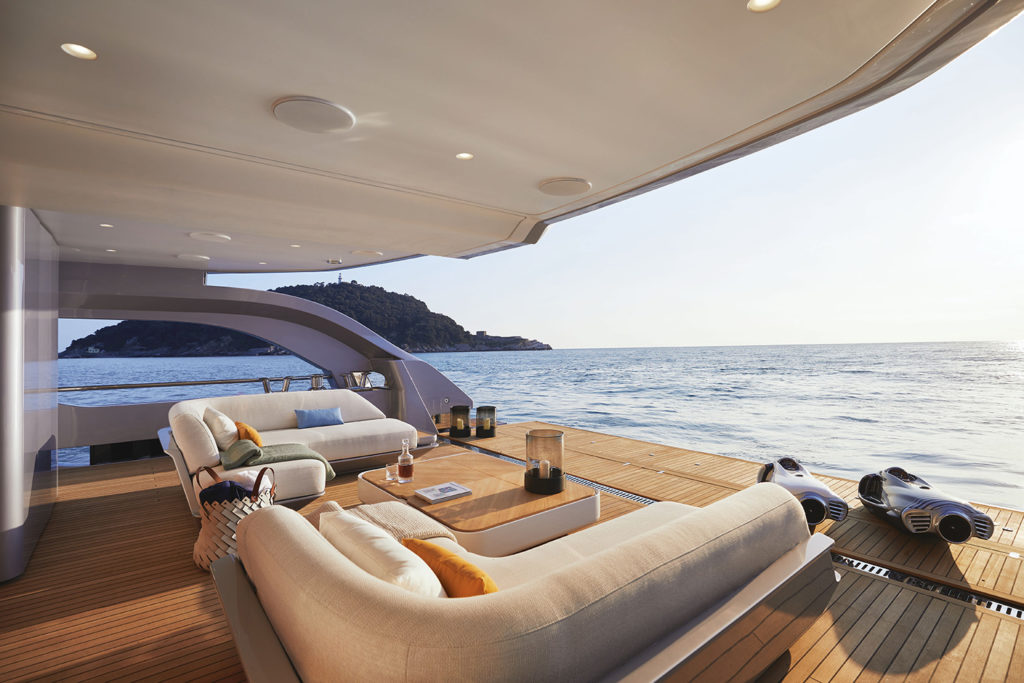
In addition to the Sea View Terrace and Beach Area, Mancini’s project creates a more secluded outdoor area. On the Main Deck, a few steps below the Sea View Terrace, the cockpit becomes a Private Patio, a protected and reserved living area perfect for eating or lounging while moored stern-to. It is a hybrid area, located outdoors yet indoors, becoming the natural extension of the main salon into “plein air” and blurring the threshhold for an even smoother transition.
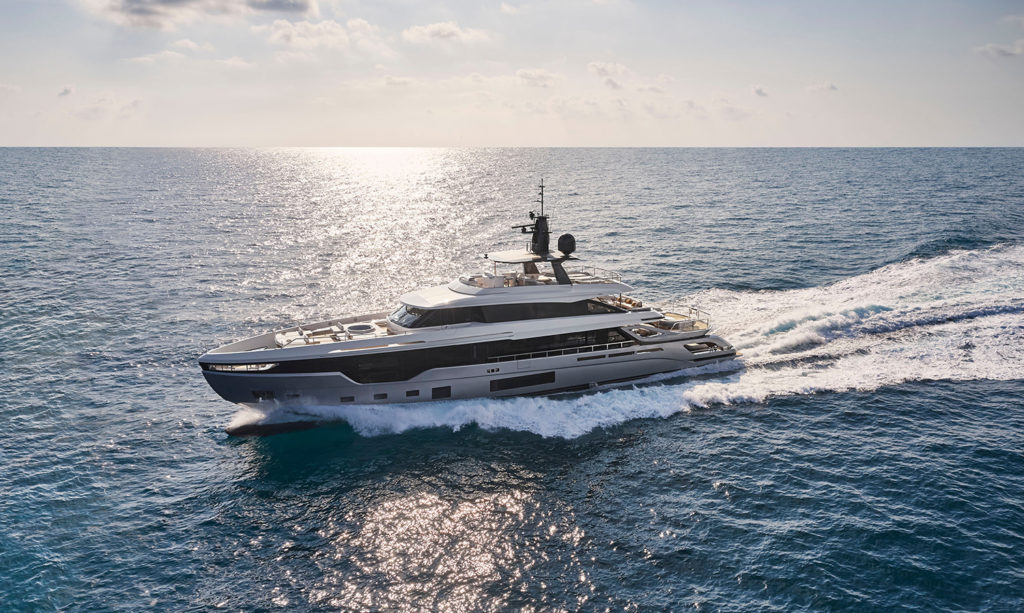
The third terrace is the main outdoor dining area, aft of the Upper Deck, which develops around the square table (extendable to seat up to 12) of handcrafted natural teak with white lacquered inserts. The area is rounded off by corner sofas for aperitivo and a series of furniture for the service.
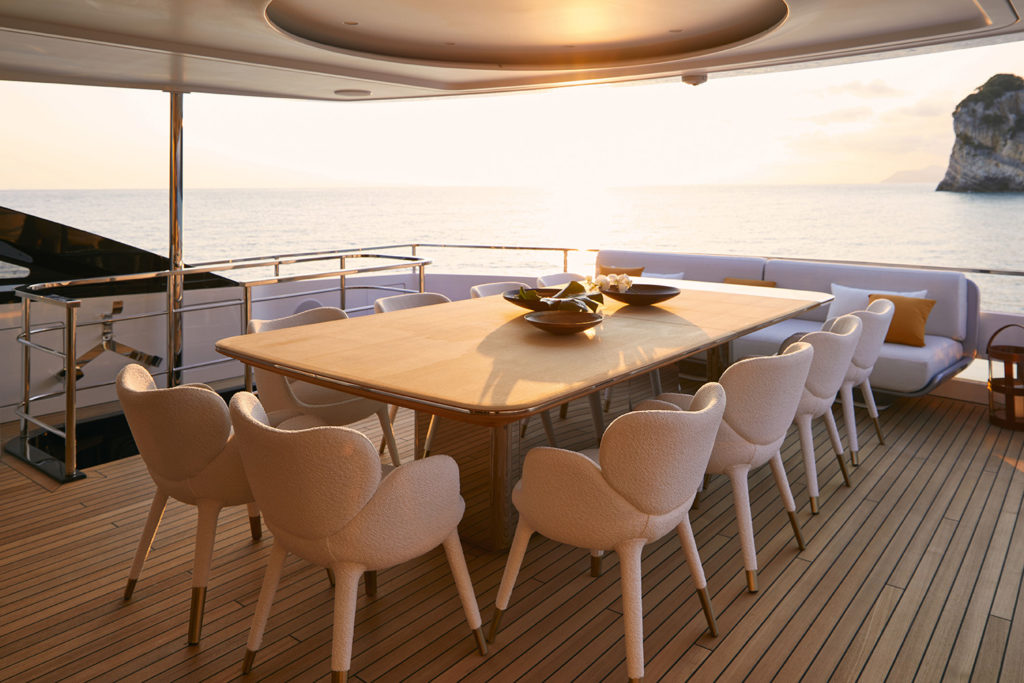
Topping off the cascade of terraces is the Sun Deck, which comes with a large sunbathing area at the stern with freestanding furniture and a view overlooking the sea. There is a lounge area with opposing circular sofas, with a table for lunch in the center and towards the bow, an American bar overlooks the horizon with a large barbecue.
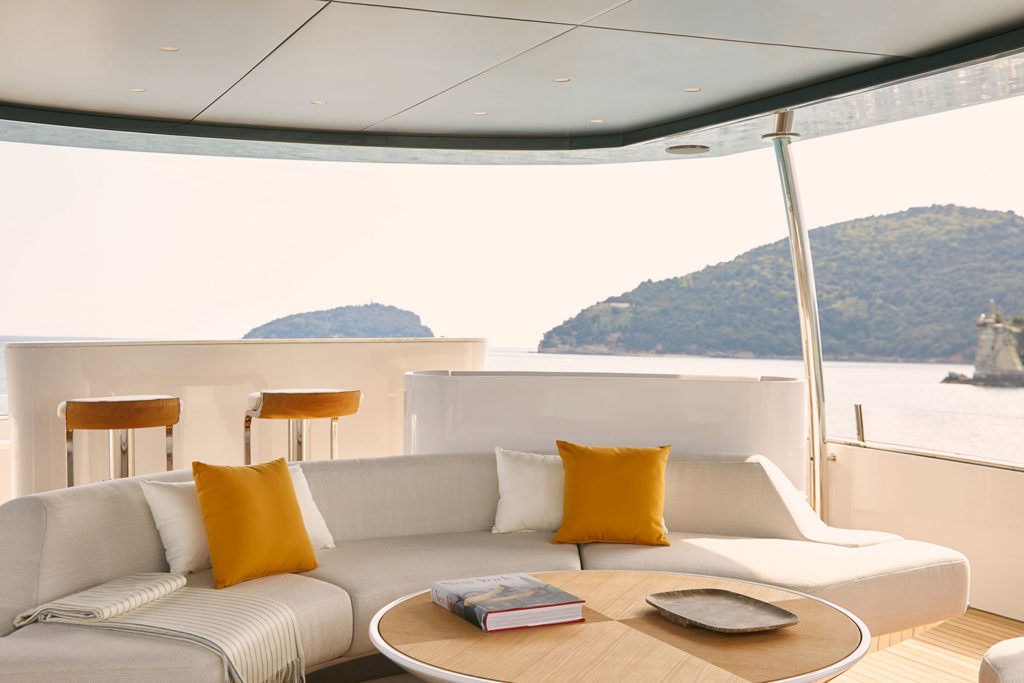
On the Trideck, Mancini’s sporty touch, typical of his projects for Azimut, has evolved to approach the modern yet elegant lines of a true flagship. The clean lines dominate everything, from the large windows that create a continuous, uninterrupted surface up to the stern, to the sloping windshield that ends with a vertical bare-headed windbreak on the Sundeck.

With a modern stylistic language also seen in car design, Mancini lightens the external lines, restoring a feeling of dynamism, a difficult task considering the vast internal volumes on this 38-meter yacht. The designer sculpted the hull with a rib that starts from the stern, at the height of the exhausts and extends to the bow, moving and giving tension to the profile. The fairleads themselves are styled and incorporated to enrich the design.

As for the other models in the Grande Collection, Azimut Yachts relied on Achille Salvagni for the design of the interior spaces and furnishings. The designer fully embraces the cause of the shipyard: to offer the market a redefinition of the role of space, giving new functionality to the onboard environments.

Salvagni works on two levels: function and style. First of all, he carries out a functional rethinking of the interior spaces, for which he abandons the preconceived functions of each area. The goal is to transform the yacht into a place where the owner can live without constraints, in a more liquid and accomodating space. To this end, the interiors have been dilated and integrated with the external areas, to become extensions of one another, a harmonious continuum. It follows naturally to move the main indoor dining area from the Main Deck to the Upper Deck: a solution that fully dedicates the main deck to a more relaxed, successful social area.

Salvagni does not limit himself to redefining the environments onboard, but also enriches them through a close attention to décor, favoring the tension between forms and the purity of the line, abandoning any ostentation at the same time. By virtue of this principle, Salvagni has designed every single piece of furniture on board, choosing to remove the superfluous and let the pleasures of touch and shape give the living areas an ambience of wellbeing.

The perceived quality of the environment in its entirety is of the highest level, thanks to a skillful combination of materials, colors and finishes.
Access to the lounge from the Private Patio is smooth and effortless. Entering, one finds an airy, large, bright environment thanks to the floor to ceiling windows, with soft colors for the fabrics and the walls livened by glossy mahogany inserts that accentuate its elegance with contrast.

Without the traditional formal dining area, the lounge is set up to encourage conviviality. The bar cabinet, featuring a top made of Carrara marble with a built-in table lamp, welcomes guests and serves both the lounge and the adjacent outdoor area. The heart of the space are some important pieces of furniture: the large enveloping sofas with soft and seductive lines; the armchairs with a unique design; and the coffee tables made in a full-mold metal bath.

Every detail is designed with the attention that the flagship deserves, for example, the marble top of the storage unit integrated into the sofa that incorporates a wireless charger and the wooden floor laid in a herringbone pattern with brass inserts. Noteworthy are the circular elements embedded in the ceiling, a decoration that recalls the lunar craters and makes the white lacquered ceilings, already characterized by asymmetrical cuts, even more particular.

The first unit, at the specific request of its owner, has a high level of home automation. All the onboard utilities, lights, air conditioning, curtains, the latest generation audio and video system can be controlled from the tablets supplied, including a huge 77 “ultra-flat TV that comes out electrically from a special compartment on the Main Deck.

Forward on the Main Deck is the owner’s suite, full beam with large windows, and conceptually broken down into special regions, starting from the entrance as a lobby/dressing area. The main material is tay wood, clear and clean, contrasted against a polished mahogany. The floor is made of textured Cardoso stone. In this area too, the lights, as well as the furnishings, are special pieces designed by Salvagni.

Among these stand out two large suspended dressers, illuminated from below by LED lights that accentuate the floating effect, the bedside tables embellished with brass inserts and the breakfast table suspended between two armchairs. Imagining the next expression of a growing trend, Salvagni begins to evolve the bathroom into a wellness area, centered around the large freestanding tub which doubles as a rich design element.

This new pleasurable area is accessible by a large auto-sliding door, not as an addition, but as a natural extension of the master suite. With the door wide open, the combined space becomes a temple of relaxation and comfort. And the build is a testament to Italian craftsmanship: the countertops are Cardoso stone, finished smoothely, and the seat in the shower was cut from a single block of the fine material, while the bathroom walls are embellished with mahogany elements. The large round central tub enriches the rest of the cabin, prominently located as a gravitational attention center that holds the space together.
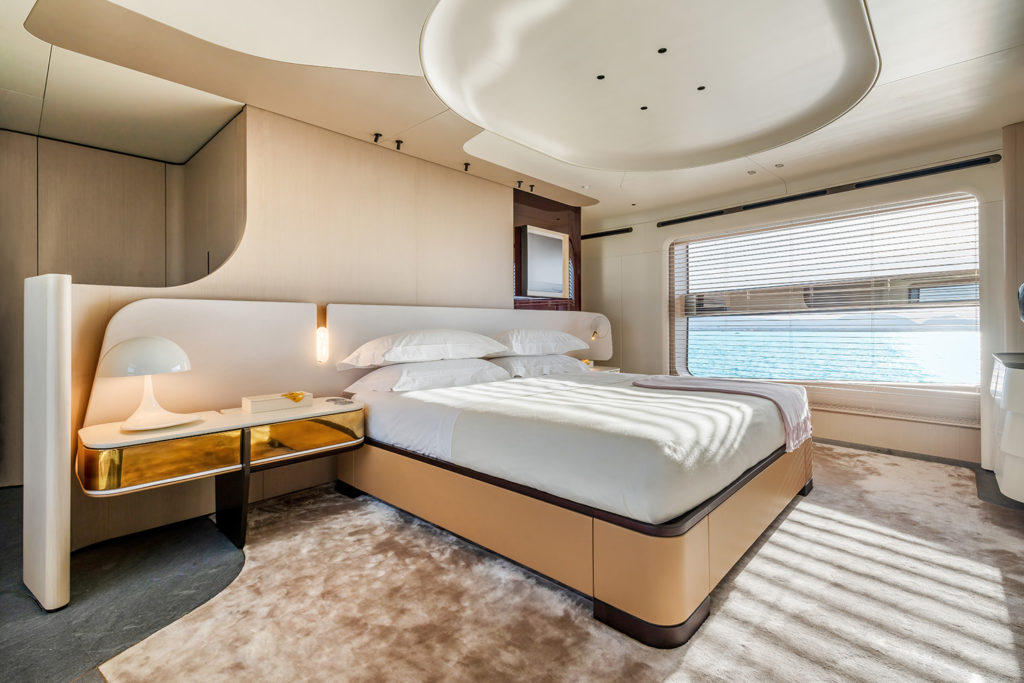
The formal dining area is located on the Upper Deck. Formal, however, does not mean conventional, the skylounge being conceived as a multipurpose area. Most of the time, people prefer to eat outdoors. The Sky Lounge on the Upper Deck is shaped as an intimate nook, with a huge cozy sofa and convertible table, an attractive spot to come inside after dinner, especially for movies, equipped with a 55” pop-up flatscreen. When guests wish to dine indoors, the table can be raised and extended to serve as the main indoor dining, accommodating up to 12 guests.

The flexibility of the layout is further improved by the options offered to the owner. The first units ordered all request the sixth unprecedented VIP cabin positioned on the Upper Deck, therefore with a beautiful sea view thanks to the large window, while the captain’s cabin is located on the Lower Deck. More traditional layout solutions are also available, with an enclosed pantry and a captain cabin on the upperdeck just behind the bridge and with a formal dining area in the fore part of the main salon.

The command area is a blend of elegance and technology, characterized by a futuristic helm that integrates all onboard systems with Simrad Command.
Further forward, there is a sprawling lounge area, with sunpads surrounding the circular whirlpool tub, a lounge area with opposing sofas and then a further sunbed area towards the bow, sheltered by a mini windscreen. On the Lower Deck there are four en-suite guest cabins: two VIPs aft and two guest cabins forward.

The Azimut Trideck offers innovative design solutions, starting from the tonnage, which remains below 300 GT despite the generous interior volume. This is made possible thanks to the large beach area, which is kept partially opened. The extra space is therefore available for an expanded living area with a special focus on the full beam skylounge.

The first of the most significant elements of the Trideck from a technological point of view is the debut of the new second-generation D2P® Displacement to Planing hull. Designed by Pierluigi Ausonio together with the Azimut-Benetti Research and Development Department, the hull benefits from proprietary CFD software, FEM analysis and form optimizations to yield unrivaled results in terms of efficiency. The Grande 35Metri, featuring the first generation D2P hull was already best in class, and the second generation debuts on the Trideck with substantial improvements.

Despite being 3 meters longer, 30 GT larger and 35 tons heavier, the Trideck consumes fuel at the same rate as her smaller sister at all speeds above 19 kn, and manages to be 15% more efficient at a cruising speed of 15 kn. To put these results in context, when compared with a traditional hard chine hull, the improvement in displacement fuel efficiency reaches over 40%.

The D2P® hull is based on the combination of three main elements: the double chine, which gives stability at displacement speeds while reducing drag at higher speeds; the bow wavepiercer, increasing the hull length at the waterline, reducing displacement consumption and reducing pitching in rough seas, and finally the central skeg, that guarantees optimal course stability, especially in aft quartering seas.

The Trideck is the newest member of the Carbon Generation, with her entire superstructure laminated in carbon fiber for a 30% local reduction in weight and an absolute weight reduction of 6 tons. In this way, despite the increased volumes onboard, the Trideck’s low center of gravity is preserved, guaranteeing excellent static and dynamic stability. The combination of the D2P® hull and carbon superstructure mean a significant improvement in performance: lower fuel consumption, higher speed and longer range.

The Trideck features an advanced power management system by SeaEnergy, which allows the automatic optimization of onboard electricity consumption through a perfect balance of shore power and the generators (or only between generators when at sea) depending on the energy needs of utilities. For even more freedom, owners can also add Hotel Mode to the Trideck. This means being able to relax, anchored in a bay with zero emissions and in total silence. With a lithium battery pack of about 130 kWh, the Trideck can operate the main onboard utilities with the generators switched off for up to 4 hours during the day and 8 hours at night.

The cruising comfort is improved by a highly integrated software called Argo, designed and supplied by CMC Marine, to automatically harmonises the movement of the electronic stabilizing fins with the autopilot, avoiding waste and ensuring smooth sailing. Grande Trideck has a dual-motor option, with a pair of MTUs of 2400 or 2600 hp each. The first model under test, with an engine of 2600 hp, recorded a maximum speed of 24 knots, a range of 700 miles at 19 knots and, at a cruising speed of 12 knots, an autonomy of over 1700 miles.





